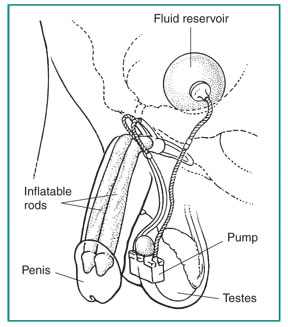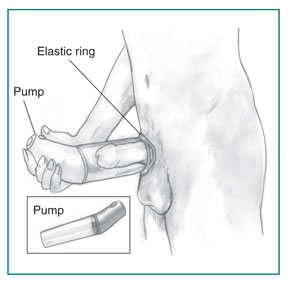Erectile dysfunction or impotence may not be a life-threatening ailment but has a significant and serious impact on psychological wellbeing and quality of life. The aim of treatment is to diagnose and treat the cause of the condition when possible.
Apart from specific therapies to treat the condition, several lifestyle measures to prevent the condition are also important. In most cases the condition is not curable but, where appropriate, curative therapies can be made available. These therapies can be selected according to efficacy, safety, invasiveness, cost and preference of the patient. Steps and methods in treatment of erectile dysfunction include:-
Lifestyle changes
Physical activity and maintenance of healthy body weight reduces the risk of erectile dysfunction. The patient is advised to give up smoking and use of recreational drugs of abuse and reduce alcohol intake. Reduction of stress also helps in prevention of impotence.
Medications
Phosphodiesterase type-5 inhibitors – Several oral drugs of the class phosphodiesterase type-5 inhibitors like sildenafil, tadalafil or vardenafil may be effective and sometimes need only be used short-term for relief from symptoms of impotence. These agents improve the relaxation of smooth muscle. Efficacy of the drug is dependent on release of nitric oxide from the nerve endings of the cavernosal nerve.
These drugs cannot be used in patients receiving nitrates for diseases like angina. In these patients there may be a severe fall in blood pressure which may lead to acute myocardial infarction (heart attack), stroke and even death. Those with a history of low blood pressure, ischemic optic neuropathy, recent stroke, unstable angina or heart attack are also not prescribed these drugs.
Sildenafil (Viagra) is generally well tolerated and effectiveness is reduced after a fatty meal. 50 mg is the recommended starting dose and side effects are rare. The effects start after 30 minutes and peak effect is seen at 2 hours and lasts up to 36 hours. Vardenafil is effective after 30 minutes. It is useful in non-responders to Sildenafil. Effect reduced by fatty meals.
Apomorphine hydrochloride – This drug acts by enhancing centrally-acting erectile signals. It is a dopamine agonist. It has a more rapid onset of action and is taken as a pill placed under the tongue 20 minutes before sexual activity. It is best effective in patients with mild-to-moderate erectile dysfunction. It is less effective than sildenafil.
Yohimbine – This agent has been used for over a century as an aphrodisiac. It acts both on the brain and the genitalia. It has a modest effect especially in psychological causes of erectile dysfunction and does not act on physical causes of the condition. This drug is not licensed for National Health Service (NHS) treatment in the UK but used as a natural remedy by many patients.
Delequamine – This is a similar agent as yohimbine.
Trazadone – This an antidepressant drug associated with prolonged and painful erections. This is not prescribed for erectile dysfunction.
Prostaglandin analogues like Limaprost are alprostadil derivatives. It has been tried in erectile dysfunction. Sometimes intrauethral alprostadil is also used. Here the drug is inserted as a pellet into the uretha at the tip of the penis and this produces an erection after about 15 minutes. Alprostadil is harmful for an unborn baby and so condoms or other barrier contraception must be used if the sexual partner is pregnant. Alprostadil may also be given as injections into the cavernosa. This produces an erection lasting less than one hour. Side effects include pain.
Red Korean ginseng has an unknown mechanism of action.
Vacuum devices
These devices are shaped like an external cylinder fitted over the penis to allow air to be pumped out. This results in engorgement of penis with blood. This helps best when the partner is understanding and motivated. Side effects include pain, bruising and numbness.


Penile prosthesis
These are artificial extensions used over the penis. The material is semi-rigid, malleable or inflatable that is surgically inserted into the penis to produce an erect state.
Hormonal therapy
In patients with testicular failure testosterone is used for treatment. Those with pituitary or hypothalamic causes of impotence need to be treated with various hormonal agents.
Surgery
Patients with pelvic or genital injury may develop Post-traumatic arteriogenic erectile dysfunction. Diagnosis is made using duplex ultrasound and arteriography. Surgery shows around a 60-70% success rate.
Treatment of Psychosexual causes
This involves treating the underlying psychological problem. These patients may benefit from sex therapy and counselling, cognitive behaviour therapy and group psychotherapy. These may be used in conjunction with physical therapies. Successful outcomes in 50-80% of patients may be seen.
Pelvic floor muscle exercises
There are studies that show that exercises of the pelvic floor muscles may help prevent impotence. These exercises benefit a group of muscles around the underside of the bladder and rectum, as well as at the base of the penis.
Sources
- http://www.patient.co.uk/doctor/Erectile-Dysfunction.htm
- http://www.nhs.uk/Conditions/Erectile-dysfunction/Pages/Treatment.aspx
- www.bbc.co.uk/…/erectile_dysfunction.shtml
- http://www.ncbi.nlm.nih.gov/books/NBK38721/
- kidney.niddk.nih.gov/kudiseases/pubs/ed/ErectileDysfunction_508.pdf
- http://www.uroweb.org/gls/pdf/Male%20Sexual%20Dysfunction%202010.pdf
- http://www.urologyhealth.org/content/moreinfo/edprimtreatment.pdf
Further Reading
- All Erectile Dysfunction Content
- What is Impotence (Erectile Dysfunction)?
- Erectile Dysfunction, Causative Factors and Complications
- Impotence (Erectile Dysfunction) Diagnosis
- Impotence (Erectile Dysfunction) History
Last Updated: Jun 4, 2019

Written by
Dr. Ananya Mandal
Dr. Ananya Mandal is a doctor by profession, lecturer by vocation and a medical writer by passion. She specialized in Clinical Pharmacology after her bachelor's (MBBS). For her, health communication is not just writing complicated reviews for professionals but making medical knowledge understandable and available to the general public as well.
Source: Read Full Article
